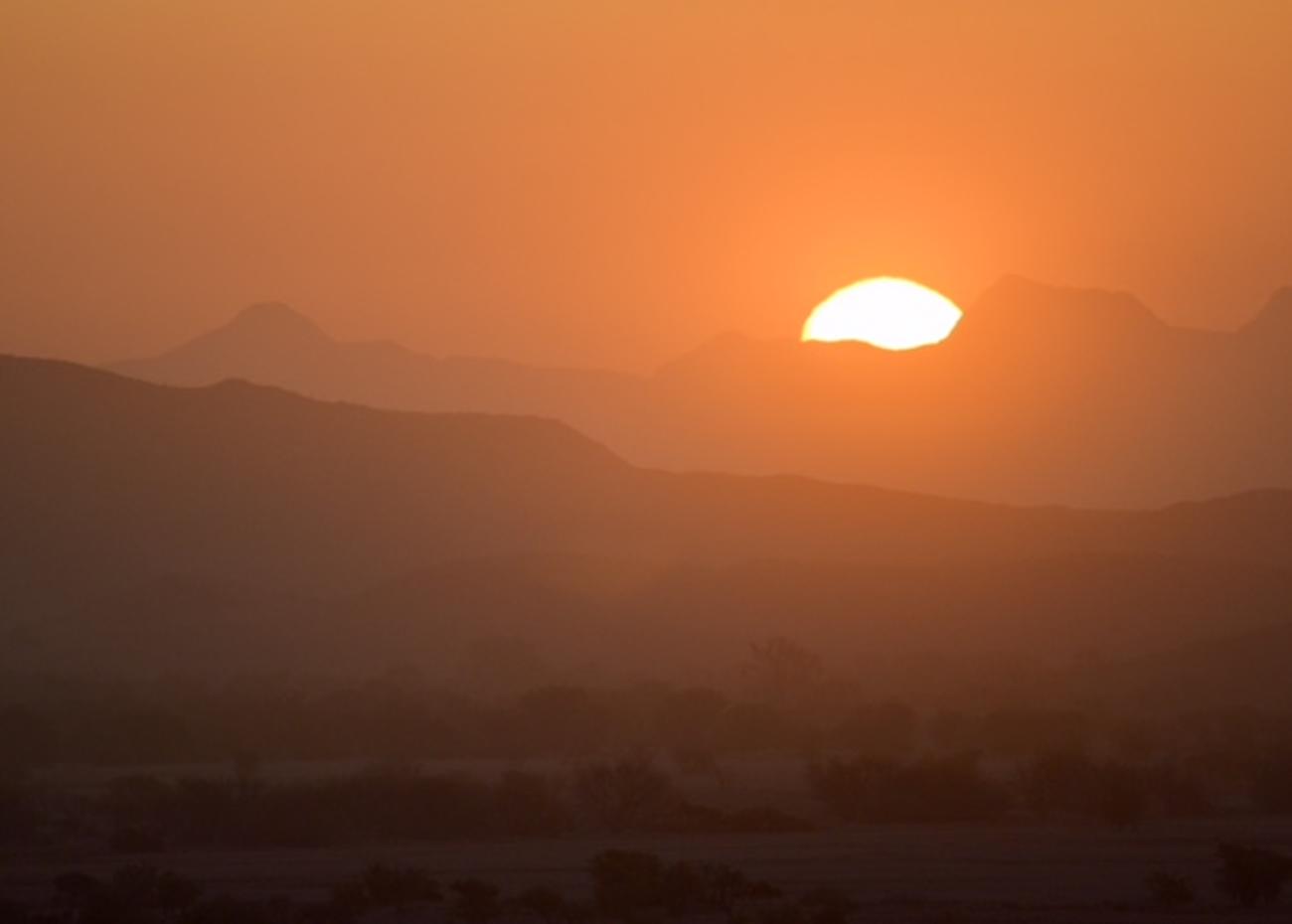Christopher Isles and his wife Karen spent a week in Namibia. Here Christopher describes climbing towering sand dunes, discovering ancient rock art, spotting lions and elephants and much more.
Day One
We arrive at Kulala desert lodge in a 4 seater Cessna from Windhoek 32 hours after we left home. A huge barman called Christopher greeted us with a smile, ice cold cloths and a ginger and lime shot. The lodge was set in its own private reserve, slap bang in the middle of the Namibian desert, with views across to the Sossusvlei dunes. Our room was a comfortable semi tented chalet. There was no air con but if you wrap yourself in a damp towel and lie on the bed with the fan on then it’s fine. We rather liked the three canisters on the dressing table: the first contained insect repellent, the second was labelled Doom and the third had a red hooter on the top (shades of the Deathly Hallows in Harry Potter). Doom is for spraying large insects and killing them instantly apparently while the red hooter is to press if you suddenly find a snake or a scorpion in your room.
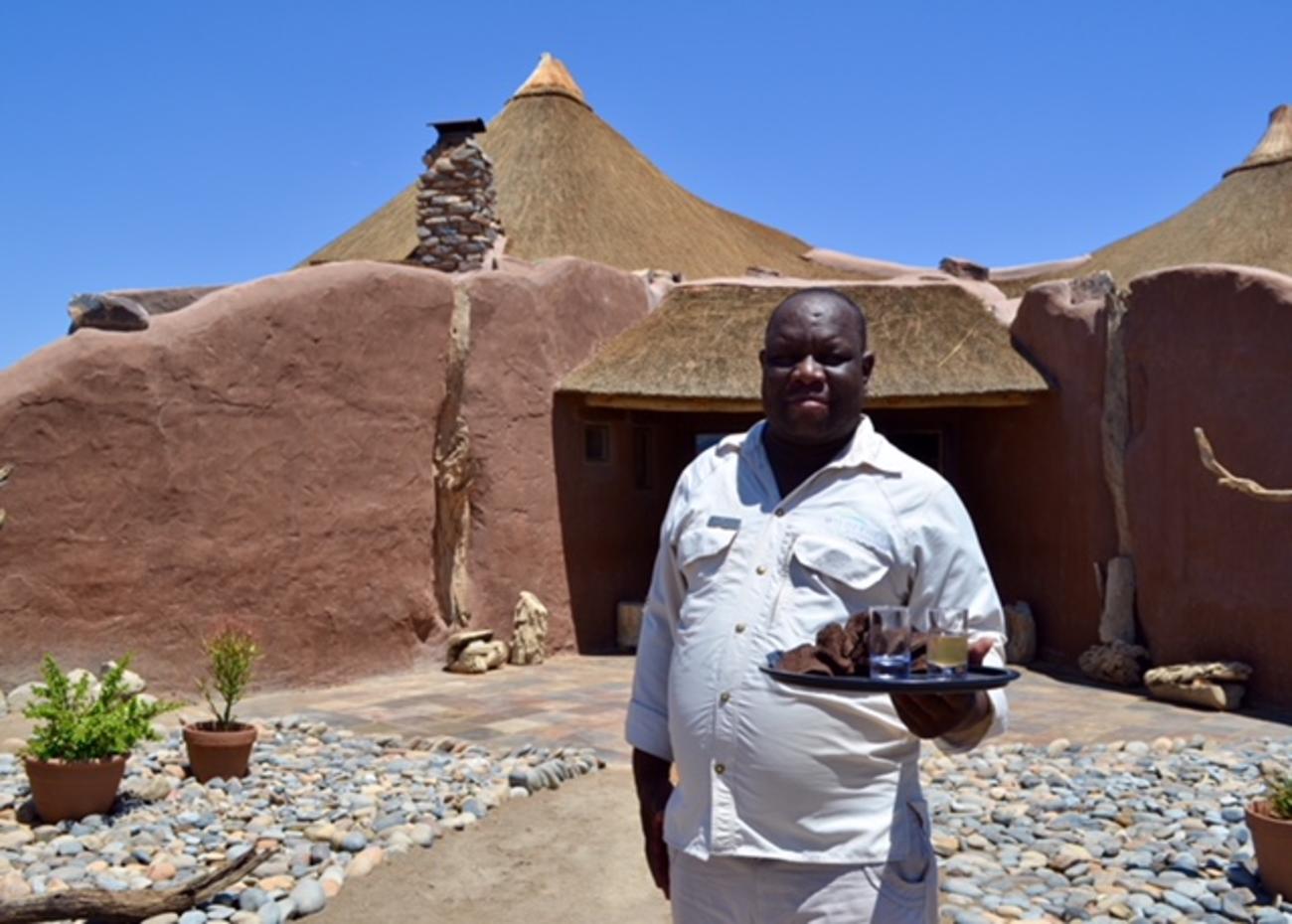
Day Two
Alarm call at 0530 for a 0630 start and a trip to the Sossusvlei dunes, easily one of the highlights of our adventure. Michael our guide drove us for about an hour stopping only briefly to admire and photograph oryx, springbok and ostrich. ‘Oryx at 11 o’clock’ became a familiar call. We even saw a brown hyena, a rare sighting in these parts apparently. Quite how these animals have adapted to survive in this waterless hostile climate must remain one of Iife’s enduring mysteries. And so to the dunes, the first of Namibia’s UNESCO world heritage sites. Quite unlike anything we could have imagined. Namibia’s most iconic landscape. Our mission was to climb Big Daddy, a dune around 320 metres before the sun rose too high. This was an hour long slog up a ridge of soft sand that wasn’t hugely different from walking through soft snow. The views from the summit were simply stunning with mountains of sand stretching as far as the eye could see. From the top it only took about 5 minutes to race down the dune slip face into an eerily beautiful clay pan called Dead Vlei, home to a small forest of withered 900 year old acacia trees. The blue sky, the orange-red sand, the creamy yellow clay pan and the skeletal acacia trunks make a stunning photograph!
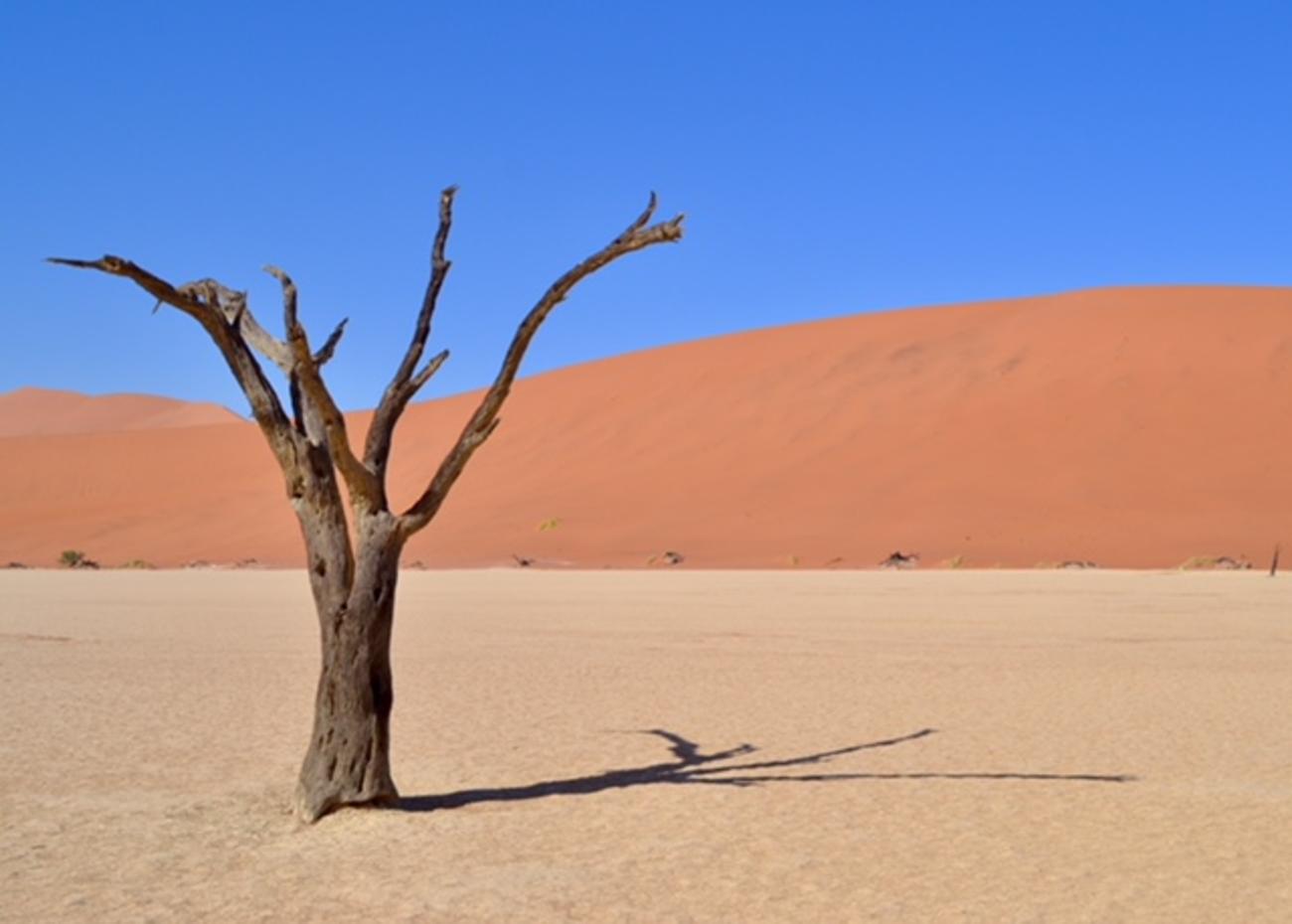
Difficult to follow Big Daddy and the dunes, though Michael found a beautiful picnic spot under an acacia tree for us before whipping out a white table cloth, cold drinks and snacks from the cool box in his jeep. Lots of birdsong and a four stripe desert mouse for company. It was far too hot to do anything but snooze after lunch so we rested up until 5pm and our next trip which was another drive along dusty roads, this time to the Sesriem Canyon. Lots of oryx at 11 o’clock, some very pretty springbok and a small herd of wildebeest to see as well. The walk along the canyon’s sandy floor was pleasant enough though the highlight of the afternoon was undoubtedly the sunset. Michael stopped his jeep on the way back to Kulala just in time to set up a makeshift bar which he stocked with a huge range of drinks from his magic cool box, and see the sun go down. Sundowners are a big thing out here and the colours were amazing!
Day Three
We leave Kulala Lodge after breakfast for the short flight to Doro Nawas camp over a rugged uninhabited landscape of dunes, desert and unforgiving mountains. The staff of Doro Nawas welcomed us with a song and then pretended they were going to serve elephant steak for lunch! We set off again at 1600 with Ballack, our new guide, in his 4x4 in search of real elephant and found not only a broody looking bull sheltering under a tree but also a small herd of six girls with their offspring including one that couldn’t have been more than a month old. Cup runneth o’er. Another highlight of our trip so far. We then saw a vulture, a warthog and a pair of steenbok (much bigger ears than a springbok) before stopping the jeep for a sundowner G&T and yet another magnificent sunset. After dinner I wheeled our bed out onto our terrace. The Milky Way never sparkled so brightly. Orion with his belt, his dagger and his bow looked magnificent while the seven sisters twinkled like diamonds in the fabulous Namibian night sky.
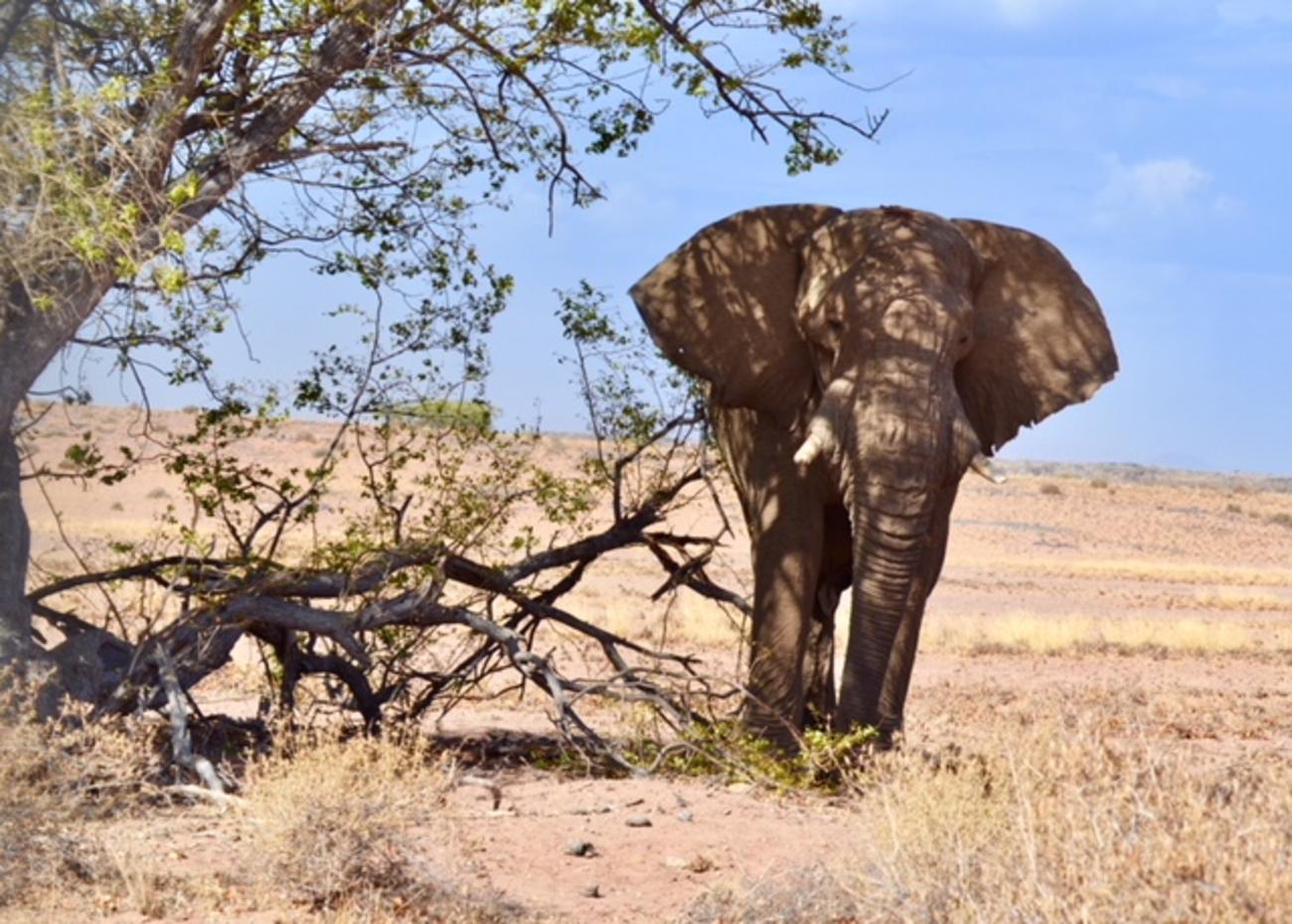
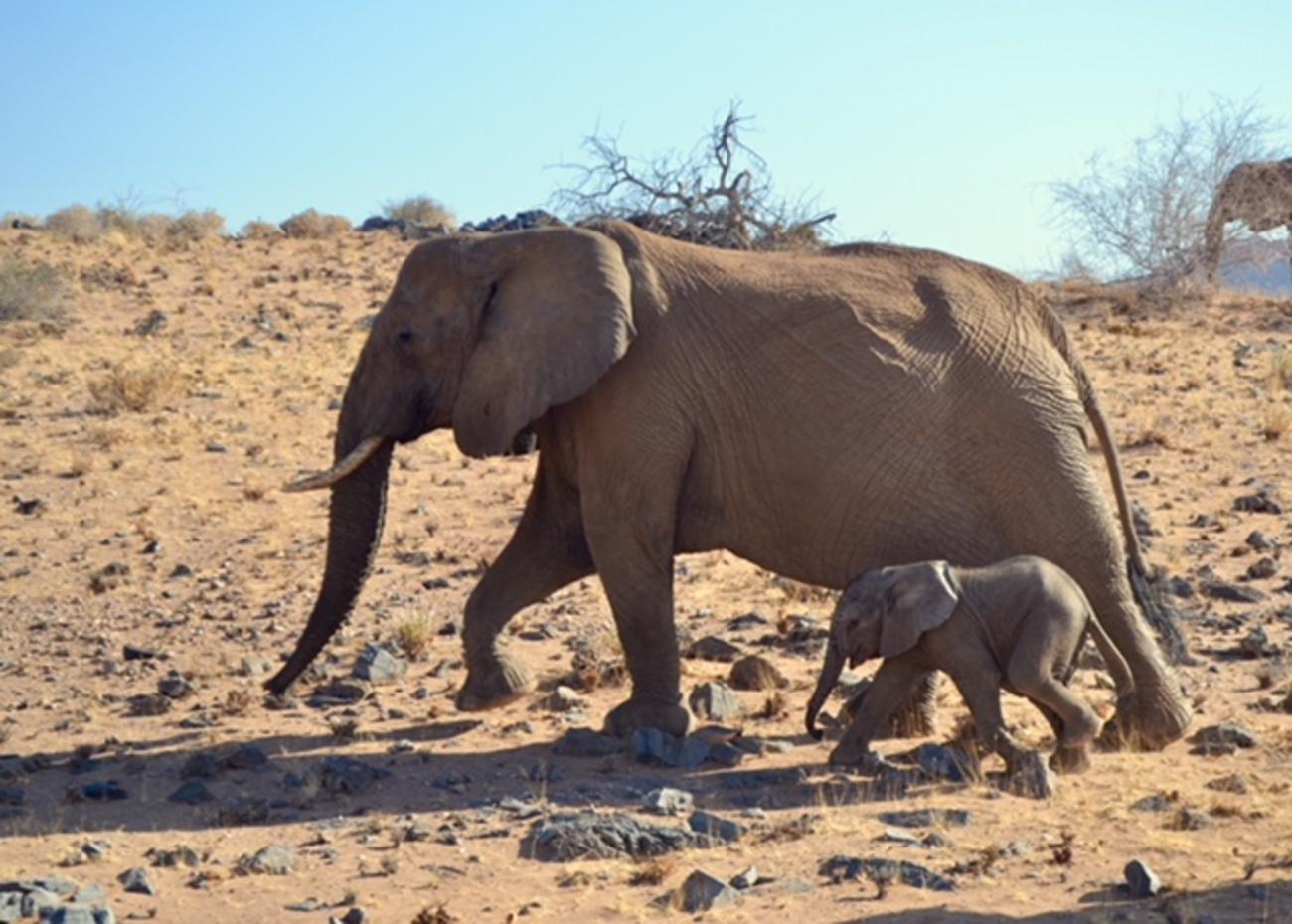
Day Four
After an early breakfast we set off again, this time in search of the Bushmen Rock Art at Twyfelfontain (literally doubtful fountain in Afrikaans), the second of Namibia’s world heritage sites. These are etchings of human and animal forms carved on sandstone some 5000 years ago by primitive hunter gatherers and presumably only preserved so well because it never rains. Worth a visit though it did occur to me that if their hunting skills were as primitive as their drawings then it is perhaps no surprise that they became extinct.
More interesting to me than the rock art was the Damara village museum, also in Twyfelfontein. Our village guide, wearing nothing more than a goatskin skirt and a few beads, took us round the village where we met his blacksmith, his pharmacist (herbal remedies only), the women who made beads out of ostrich shells and a man who made fire out of straw and donkey dung. They also showed us a game developed by Damara people which they use instead of fighting to settle scores, buy land, trade wives etc. The Damara name for this is !Gus or Owela, which roughly translates into English as African casino. Our tour ended with dancing, acapella singing and gospel rhythms by all the villagers. I realise this was a show and that the villagers don’t actually live here but they didn’t look bored and there was no pressure on us to buy anything at their shop (which was clever because it made us want to buy something). For dinner that night we ate outside by candlelight with all the other guests at a long table on the roof of the Doro Nawas desert camp under the magnificent Namibian night sky. It doesn’t get much better than this!
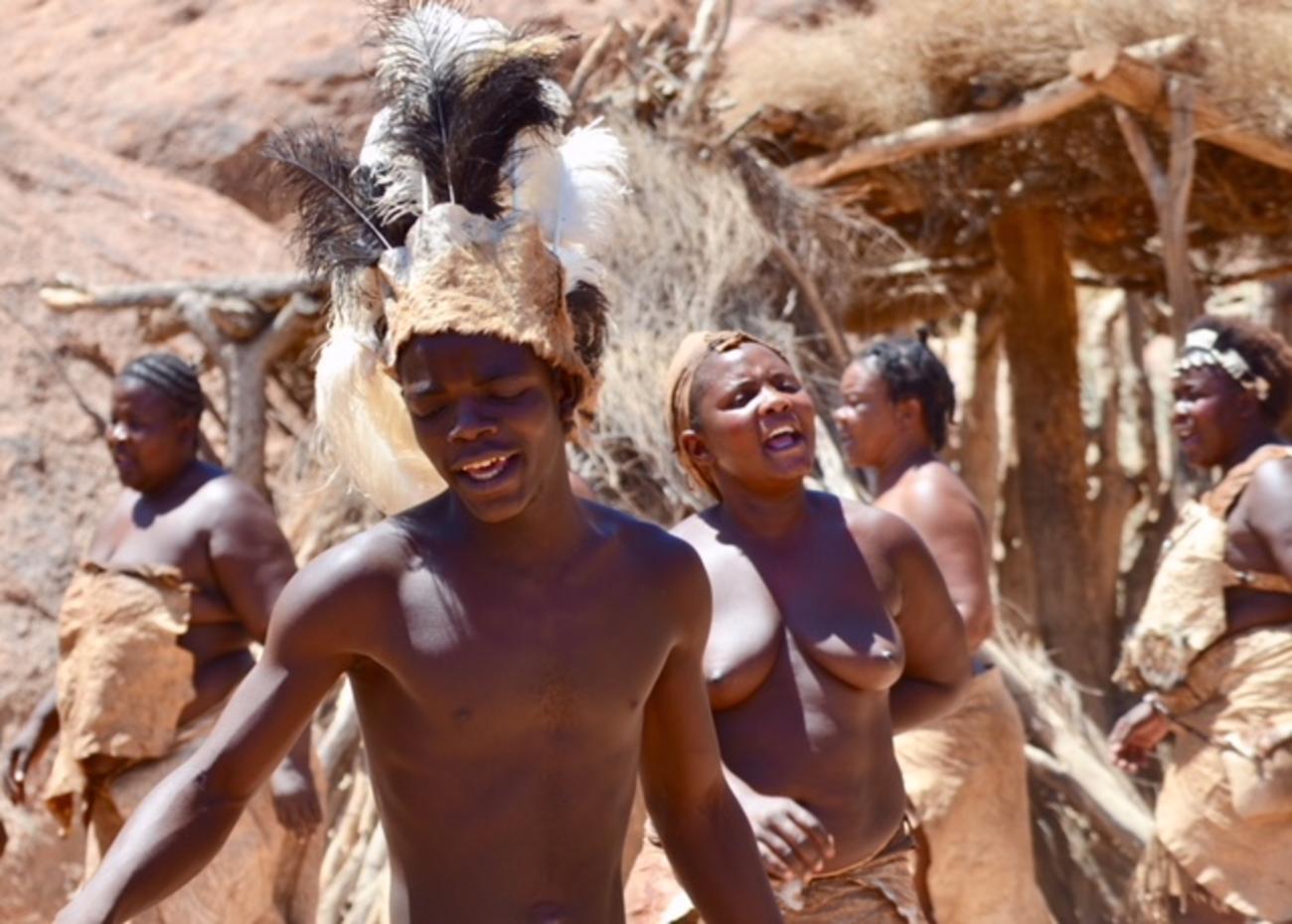
Day Five
Early morning trip to the Petrified Forest, about a 45 minute drive from Doro Nawas Lodge. Massive tree trunks were carried here by flood waters from central Africa 100 million years ago then compressed to stone containing iron, manganese and silica by the weight of a sediment that was a thousand feet deep. Ballack, my driver, teased the local guide by saying I was a geologist and that he better be good! The fact that I was the only tourist in the forest that morning only added to the pleasure. Doro Nawas sang to us again as we left for the airstrip and the short fight to Ongava in a Cessna 210 which with only four seats including the pilot has to be the smallest in the Cessna range. Karen felt it was perhaps too small. One of Ongava’s star attractions is its waterhole which meant we were able to watch impala and waterbuck at play while we were having lunch. They even had a bean to cup espresso machine so the coffee was good. We were lucky too that our chalet (No 5) had a direct view of the waterhole, so all in all this was an excellent choice.
Thursday afternoon’s safari was a real treat. It wasn’t long before we chanced upon a pride of 12 lions in a clearing. Rio knew them all well. Stumpy the male, so called because he had lost half his tail in a skirmish, was clearly interested in one of the lionesses who was making it quite clear to him that she couldn’t be bothered. Two lion cubs were having a rough game while the rest of the family looked on with bored amusement. We could have watched for hours but there was more to come. Rio began to follow freshly passed rhino poo, suggesting there were two rhinos ahead of us and that both were keeping to the track we were driving on. Sure enough it wasn’t long before we saw a huge mother rhino with her rather cute looking 8-9 month old son. Mother and son were in no hurry to move out of the way so we spent a happy half hour watching them graze as she lumbered up the grassy track and he trotted obediently behind. Cup runneth o’er again! Dinner that night was a beautifully cooked kudu steak which we washed down with a rather nice South African merlot before being escorted back to our chalet by an armed Rio, just in case the lionesses were hungry!
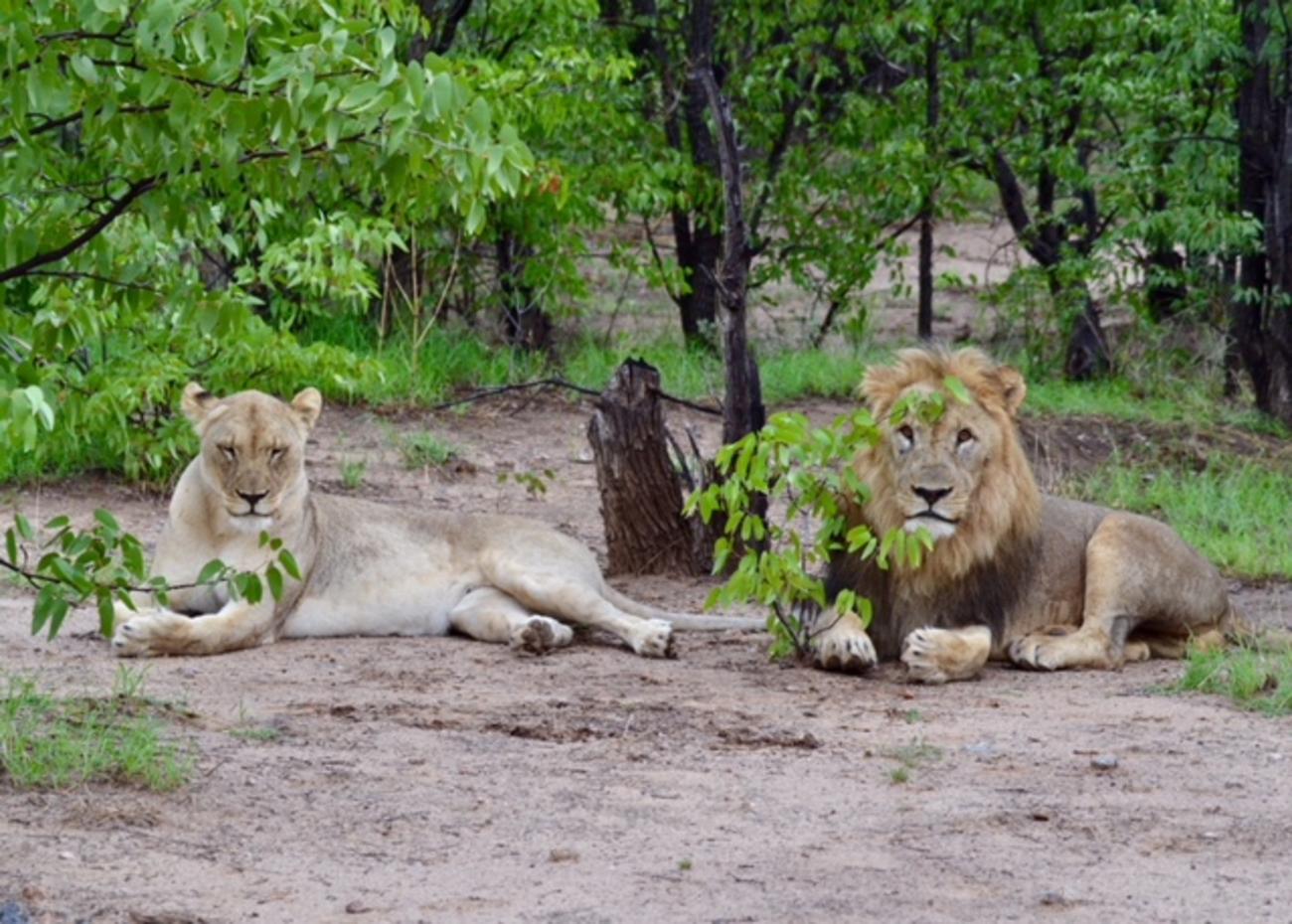
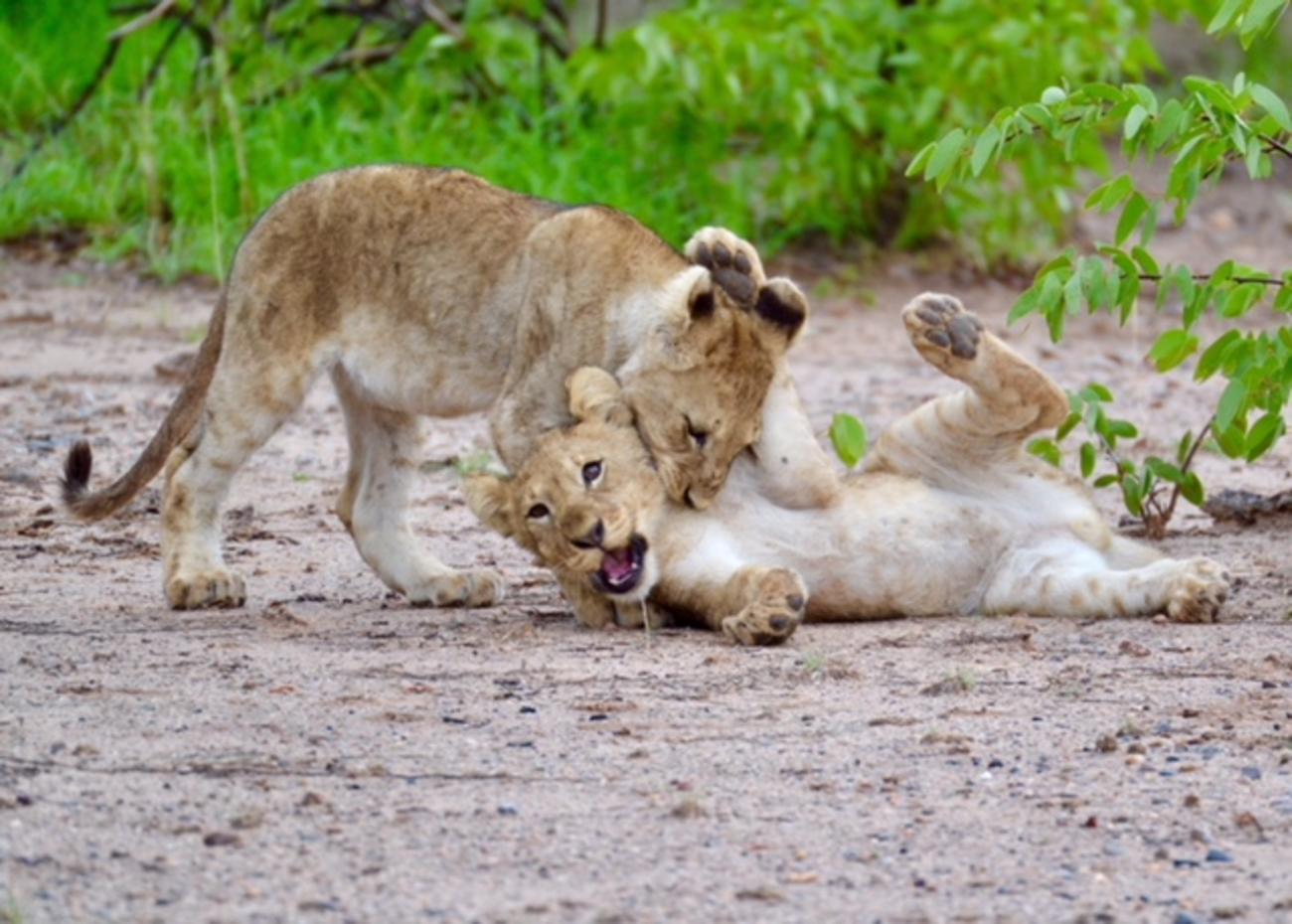
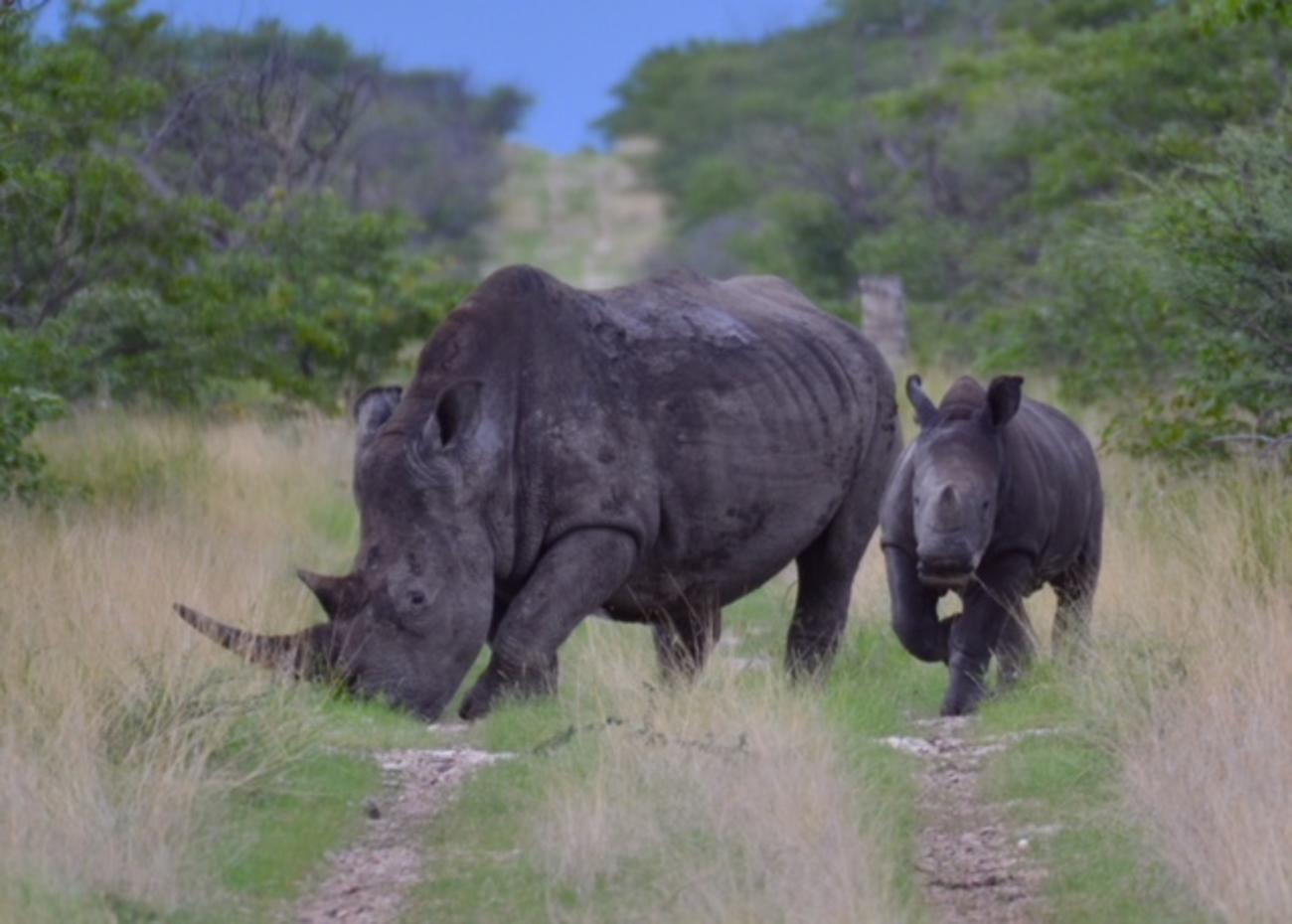
Day Six
Friday was our day out in Etosha. We left early and headed into the park with Rio, our trusty guide. Rio lives in a small village somewhere north of Ongava where he has been building a house since 2009 (when we said goodbye at the end we asked that he put our tip towards his unfinished bathroom). We asked him when might be the best time of year to visit Namibia’s game parks. We have gone in Namibia’s so called rainy season (December to March) when both tourists and big game sightings are lower in number than in the dry season which runs from April to November. The plus side for us was the feeling of having the place to ourselves rather than being one of a dozen cars queueing up to see a lion in June. The downside was fewer elephants at waterholes because they were drinking from mud pools that were hidden by trees deep within the park. You pays your money and takes your choice.
Anyhow Etosha is a huge park of scrub, small bushes and mapane trees. Driving through it felt a bit like looking out of the window on a long train journey except that we were bumping along a dirt track in the back of Rio’s Landcruiser with a lovely breeze of hot air blowing in our faces. We didn’t find a pride of lions or a mother and baby rhino today but we did see some beautiful giraffe and zebra. Several solitary male wildebeest sat on the park floor waiting for girl wildebeest to come by. A lioness and her younger brother walked very purposefully across the road in front of us at one point. There were many kudu with their magnificent horns, black faced impala and springbok by the plenty. And then there were the birds. Beautifully coloured guinea fowl, northern black koorhans, kori bustards, greater kestrels, secretary birds and blue cranes to name but the ones I can remember.
Meanwhile back at Ongava there was just time for a quick G&T while we watched the play fighting by the waterhole before setting off once more with Rio, this time for a bush dinner under that amazing Namibian night sky. They do this for their guests twice a week weather permitting (which is presumably almost always) and it’s yet another huge treat though Kits felt that our proximity to big game was too close for comfort and was only partially reassured by the pre-dinner briefing we received from the warden with the shotgun. Apparently if we did come face to face with a lion or an elephant while eating dinner on no account were we to turn and run. Much better to keep staring at them and walk backwards to the jeep slowly!

Day Seven
Wonderful last breakfast at Ongava watching the impala and waterbuck by the waterhole. We had the whole place to ourselves again which added to the wonder and magic of it all. Rio then took us on a short morning safari past zebra including a baby zebra, wildebeest, impala, a large monitor lizard and a beautifully coloured lilac crested roller bird before dropping us off at Ongava International Airport (actually a thatched roof on wooden poles) for the flight to Windhoek. The crowds, mayhem and long queues at Windhoek reminded us how lucky we had been to have had the whole of the Namibian desert, its dunes and its game parks to ourselves. Welcome back to the real world!
